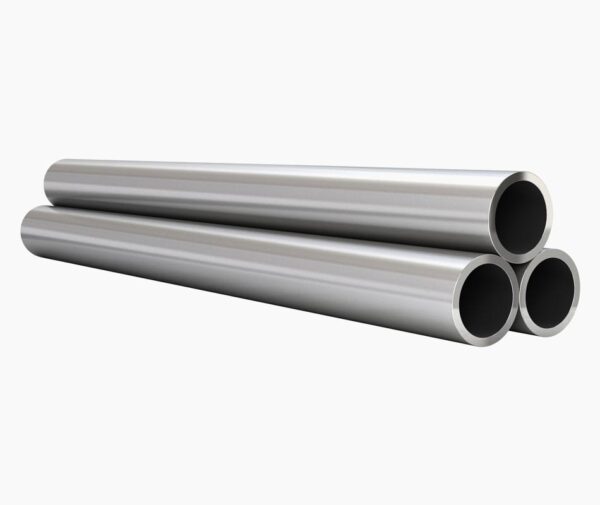Description
Unlike previous ferritic stainless steel alloys, the grade 444 has superior resistance in chloride environments, and can resist chloride stress corrosion cracking. The grade has lower thermal coefficient of expansion, with a value of 10 micrometre/m°C and hence, it can be used suitably in applications at elevated temperatures.
The poisson’s ratio of 0.27-0.30 depicts the stiffness of the SS grade. The tensile strength of the material decreases from 500MPa at 100°C to 400MPa at 500°C. The grade can be suitably forged and hot worked by heating the metal up to 1000°C, and then finishing temperature below 700°C. The metal should not be held above 1000°C for an extended period of time since that would result in grain growth and unwanted loss of ductility. The hot working needs to be followed by annealing, for stress removal and passivation of the surface for corrosion resistance.
The grade can be suitably cold worked with a low work hardening rate and has deep drawing and bending characteristics with good formability. The alloy has 65 GPa torsional modulus of elasticity at room temperature and hence can be suitably used in dynamic applications.
Chemical Properties
| Grade | C | Ni | Mn | Si | Cr | Mo | Fe | P | S | N | Ti + Nb | |
| SS 444 | Min. | – | – | – | – | 17.50 | 1.75 | – | – | – | – | – |
| Max. | 0.025 | 1.00 | 1.00 | 1.00 | 19.5 | 2.5 | 77.475 | 0.040 | 0.030 | 0.035 | 0.80 |
Physical Properties
| Density | 7.80 g/cm3/0.282 lb/in³ |
| Melting Point | 1 405-1 495°C |
| Thermal Conductivity @ 70°F | 26.8 W/mK 186 BTU in/hr.ft².°F |
| Specific Heat | 0.102 BTU/lb-°F @ 70°F 427 J/kg-°C @ 20°C |
| Electrical Resistivity | 22.50(57) |
| Modulus of Elasticity | 200 GPa 29000 ksi |
| Annealing | 760-830 C ° |
| Poisson’s Ratio | 0.27-0.30 |
| Shear Modulus | 80-83 GPa |
General Data
| Standard | SS 444 |
| UNS | S44400 |
| WERKSTOFF NR. | X2CrMoTi18-2 |
| EN | 1.4521 |
| BS | – |
| GOST | – |
| JIS | SUS 444 |
| OR | – |
Standards Specifications
PIPES & TUBES
| Summary | Standards |
| Standard Specification for Seamless Ferritic and Austenitic Alloy-Steel Boiler, Superheater, and Heat-Exchanger Tubes | ASTM A213 |
| Standard Specification for Seamless and Welded Ferritic and Martensitic Stainless Steel Tubing for General Service | ASTM A268 |
Forms of Supply
Seamless tubes.
Corrosion Resistance
The grade has resistance to corrosion in a wide range of corrosive environments. Although, the alloy has resistance to chloride environments, depending upon the concentration, the corrosion rate may vary. Nickel free grades make good resistance to chloride environments and chloride stress corrosion cracking. Also, the grade can resist under dilute sulphuric acid and concentrated sodium hydroxide environments. Since the grade has high chromium content and is molybdenum alloyed steel, there is further improvement in crevice corrosion and pitting resistance. It also has suitable oxidation resistance and can be used for the applications of the same.
Heat Treatment
The exceptional chemical composition and grain structure of the grade 444 gives it commendable thermal and physical properties. Heat treatment is thereby done on the metal when required. Annealing is normally done by heating the metal at about 800°C for 90 minutes and then air quenching. Post weld annealing might be required. Stress relieving if required, can be done about 250°C.
Weldability
- Welding can be done using conventional techniques. Electric resistance and common fusion techniques are normally used.
- The grade has satisfactory weldability. The heat affected zone is prone to grain growth.
- The molybdenum alloyed ferritic steel might make the weld more brittle than required.
- The weld has lesser fatigue strength and thus cannot be used in many dynamic applications.
- Heat input is to be kept low.
- Austenite grade fillers are normally used.
Machining
Hot working (with care about 1000°C) and cold working on the grade can suitably be done. Stretch forming is limited while the grade has excellent formability and can be suitably deep drawn and spin formed.
Applications
Food processing and wine making equipment, roofing and cladding in marine environments, hot water tanks and geysers, automotive components and heat exchanger tubings.
Possible Grade and Alternatives
GRADE SS 304
| Grade | C | Mn | Si | P | S | Cr | Ni | |
| SS 304 | Min. | – | – | – | – | – | 18 | 8.0 |
| Max. | 0.08 | 2.0 | 1.0 | 0.045 | 0.03 | 20 | 11.0 |
GRADE SS 316
| Grade | C | Mn | Si | P | S | Cr | Ni | Fe | Mo | |
| SS 316 | Min. | – | – | – | – | – | 16 | 11 | 67.845 | 2.00 |
| Max. | 0.08 | 2.00 | 1 | 0.045 | 0.030 | 18 | 14 | – | 0.03 |

